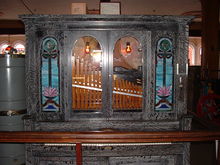- Orchestrion
-
For the album by Pat Metheny, see Orchestrion (Pat Metheny album).
An orchestrion is a generic name for a machine that plays music and is designed to sound like an orchestra or band. Orchestrions may be operated by means of a large pinned cylinder or by a music roll and less commonly book music. The sound is usually produced by pipes, though they will be voiced differently to those found in a pipe organ, as well as percussion instruments. Many orchestrions contain a piano as well.
 1918 Seeburg Orchestrion, "Style G" located at Clark's Trading Post in Lincoln, New Hampshire. Uses a 10-song music roll and plays multiple wind, string, and percussion instruments.
1918 Seeburg Orchestrion, "Style G" located at Clark's Trading Post in Lincoln, New Hampshire. Uses a 10-song music roll and plays multiple wind, string, and percussion instruments.
The first known automatic playing orchestrion was the panharmonicon a musical instrument invented in 1805 by Johann Nepomuk Mälzel. Friedrich Wilhelm Kaufmann copied this automatic playing machine in 1808 and his family produced orchestrions from that time on. One of Mälzel's panharmonicon was sent to Boston 1811 and was exhibited there and then in new York and other city's. Mälzel also was on tour with interruptions with this Instrument in USA from 7. February 1826 on, till he died in 1838. In 1817 Flight & Robson in London built a similar automatic instrument called Apollonicon and in 1823 William M. Goodrich copied Mälzel's panharmonicon in Boston, USA.
The name "orchestrion" has also been applied to three specific musical instruments:
- A chamber organ, designed by Abt Vogler in 1785, which in a space of 9 cubic feet (250 dm3) contained no less than 900 pipes, 3 manuals of 63 keys each and 39 pedals.
- A pianoforte with organ pipes attached, invented by Thomas Anton Kunz (1756–1830) of Prague in 1791. This orchestrion comprised two manuals of 65 keys and 25 pedals, all of which could be used either independently or coupled. There were 21 stops, 230 strings and 360 pipes which produced 105 different combinations. The bellows were worked either by hand or by machinery.
- A mechanical musical instrument, automatically played by means of revolving cylinders, invented in 1851 by F. T. Kaufmann of Dresden. It comprises a complete wind orchestra, with the addition of kettle-drums, side drums, cymbals, tambourine and triangle.
 London Illustrated News, Sept. 20, 1862: The Orchestrion by M. Welte, of Vöhrenbach, In the Zollverein Departement.
London Illustrated News, Sept. 20, 1862: The Orchestrion by M. Welte, of Vöhrenbach, In the Zollverein Departement.
References
- Herbert Jüttemann: Orchestrien aus dem Schwarzwald: Instrumente, Firmen und Fertigungsprogramme. Bergkirchen, 2004. ISBN 3-932275-84-5 (Orchestrions From The Black Forest).
- Q. David Bowers: Encyclopedia of automatic musical instruments: Cylinder music boxes, disc music boxes, piano players and player pianos... Incl. a dictionary of automatic musical instrument terms. Vestal, N. Y., The Vestal Press, 1988.
 This article incorporates text from a publication now in the public domain: Chisholm, Hugh, ed (1911). Encyclopædia Britannica (11th ed.). Cambridge University Press.
This article incorporates text from a publication now in the public domain: Chisholm, Hugh, ed (1911). Encyclopædia Britannica (11th ed.). Cambridge University Press.- Q. David. Bowers: Encyclopedia of Automatic Musical Instruments. ISBN 0-911572-08-2. Lanham, Maryland: Vestal Press, Inc., 1972.
- W. J. G. Ord-Hume: The Musical Box: A Guide for Collectors. ISBN 0-88740-764-1. Atglen, PA: Schiffer Publishing Ltd., 1995.
- W. J. G. Ord-Hume: Barrel organ, the story of the mechanical organ and its repair, South Brunswick, Barnes, 1978
- W. J. G. Ord-Hume: The musical box: a guide for collectors, including a guide to values, Atglen, PA, Schiffer Publishing. ISBN: 9780887407642
- W. J. G. Ord-Hume: Clockwork Music. An illustr. history of mechanical musical instruments from the musical box to the pianola, from automation lady virginal players to orchestrion, London, Allen and Unwin, 1973. ISBN 0047890045
- Arthur A. Reblitz: The Golden Age of Automatic Musical Instruments. ISBN 0-9705951-0-7. Woodsville, NH: Mechanical Music Press, 2001.
- Arthur A. Reblitz: Treasures of Mechanical Music. ISBN 0-911572-20-1. New York, The Vestal Press, 1981.
- Stanley Sadie (Ed.): Musical Box. The New Grove Dictionary of Music and Musicians. ISBN 1-56159-174-2. MacMillan. 1980. Vol 12. P. 814.
- Smithsonian Institution: History of Music Machines. ISBN 0-87749-755-9. New York, Drake Publishers, 1975.
Notes
External links
Categories:- Mechanical musical instruments
- Pipe organ
Wikimedia Foundation. 2010.
